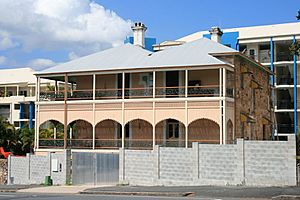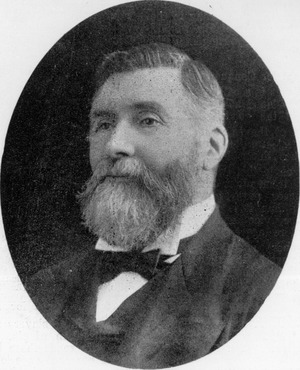Grangehill facts for kids
Quick facts for kids Grangehill |
|
|---|---|

Grangehill, 2008
|
|
| Location | 449 & 451 Gregory Terrace, Spring Hill, City of Brisbane, Queensland, Australia |
| Design period | 1840s – 1860s (mid-19th century) |
| Built | early 1860s |
| Built for | Alexander Raff |
| Official name: Grangehill, Grange Hill, St Teresa's Church Discalced Carmelite Priory and Retreat Centre | |
| Type | state heritage (landscape, built) |
| Designated | 6 September 1995 |
| Reference no. | 601668 |
| Significant period | 1860s-1920s (fabric, historical) |
| Significant components | residential accommodation – main house, views from, trees/plantings, carriage way/drive, wall/s – retaining, garden/grounds |
| Lua error in Module:Location_map at line 420: attempt to index field 'wikibase' (a nil value). | |
Grangehill is a historic house located in Spring Hill, Brisbane, Australia. It was built in the early 1860s for Alexander Raff, a very important person in early Queensland. The house is also known as Grange Hill and St Teresa's Church Discalced Carmelite Priory & Retreat Centre. It is officially protected as a heritage site, added to the Queensland Heritage Register on 6 September 1995.
The Story of Grangehill
Grangehill is a large stone house built in the early 1860s. It was the family home of Alexander Raff. He was a well-known person in Brisbane and later became a member of the Queensland Parliament.
Alexander Raff was born in Scotland in 1820. He moved to Australia in 1845. After living in Victoria for a while, he arrived in Brisbane in 1851.
Alexander Raff was very active in many groups. He helped lead the Brisbane School of Arts and the Queensland Philosophical Society. He was also the first president of the YMCA in Queensland. He helped start the Brisbane Children's Hospital in 1878. He also had business interests, including farming on the Darling Downs.
From the 1880s, Alexander Raff was a partner in a company called Smellie and Co. He also served as an elder in the Presbyterian Church.
In 1865, Alexander Raff was given an important job. He became the Official Assignee of Insolvent Estates. This meant he helped manage the money of people who couldn't pay their debts. Later, he became the Curator of Intestate Estates. This job involved managing the property of people who died without a will. In 1884, Alexander Raff was chosen to be a member of the Queensland Legislative Council. This was like being a politician, and he held this position until 1910.
Alexander Raff married Elizabeth Millar Patterson in Sydney in 1862. They moved to Brisbane soon after.
Alexander Raff bought the land for Grangehill in 1860. The family's first child was born in 1863, and Grangehill was listed as their home. This means the house was likely built between 1860 and 1863. We don't know who designed the house. However, James Cowlishaw is a possible architect. He designed other buildings for Alexander's brother.
Over the years, some changes were made to the house. In the 1880s or 1890s, verandahs were likely added to three sides of the house. Also, bay windows were added to the front.
Alexander Raff passed away in 1914. He left the house to his eldest son, James. After World War I, the Red Cross used Grangehill as a place for soldiers to recover.
In 1924, architects designed changes to Grangehill. They turned the large house into two separate apartments. James Raff lived in one of these apartments for a short time. Later, in 1929, the property was divided into smaller blocks.
From 1939, Grangehill was used as a boarding house. During World War II, American soldiers used the house. James Raff died in 1939. The house was then left to his nephew.
In 1949, the Raff family sold Grangehill. The Discalced Carmelite Fathers bought it in 1950. They used it as their main office and a retreat centre. They made some changes to the house between 1965 and 1970. This included adding a new wing and removing some bay windows. Later, a new retreat centre building was added next to the house.
What Grangehill Looks Like
Grangehill is a two-storey house built from Brisbane tuff and sandstone. It has a hipped roof made of corrugated iron. The house sits on a high spot above Gregory Terrace. From here, you can see great views of nearby areas like Fortitude Valley and Bowen Hills.
The roof has a raised central skylight and two tall chimneys. The house has verandas on two sides. These verandahs have pretty cast iron railings and timber posts. The ground floor verandah walls are made of stone. The main entrance has a timber door with glass panels and the name GRANGEHILL in the glass above. On either side of the entrance are bay windows.
The back of the house is mostly made of sandstone. It has multi-paned sash windows. A newer two-storey section was added to the northwest side. This part has a large crucifix on its wall. Another extension, used as a retreat centre, was added to the southeast side. This part is made of brick.
Inside, the house has plastered walls and ceilings. Many parts are made of cedar wood, including doors and the staircase. The ground floor has a central entrance hall. There are large rooms on either side. One room has a fancy plaster ceiling and a marble fireplace. Another room has a wide arch dividing it. It also has special painted glass panels above the doorways.
The staircase leads to the first floor. This floor has a central hall and several rooms. Some parts of the house have been updated, like the bathrooms.
The grounds around Grangehill are also important. There's a curved driveway leading up to the house. You can see two large Fig trees near the driveway. There are also Umbrella and Camphor Laurel trees. A stone wall runs along the front of the property on Gregory Terrace.
Why Grangehill is Important
Grangehill is a special place listed on the Queensland Heritage Register since 1995. It meets several important criteria:
- Shows Queensland's History: Grangehill helps us understand how Spring Hill grew as a residential area in the 1800s.
- A Rare Example: It is one of the oldest houses still standing in Brisbane. It's a rare example of a large stone house from the 1860s. Many of its original features, like ceiling decorations and timber work, are still there.
- A Great Example of its Type: Even though it was changed over time, the house still has many of its original parts. It shows what a large Victorian-era home looked like.
- Looks Beautiful: The house and its grounds, including the driveway and stone wall, look very nice. They add a lot to the beauty of Gregory Terrace and Spring Hill.
- Connected to Important People: Grangehill was built by Alexander Raff, a key businessman and farmer in early Brisbane. The Raff family helped start many businesses and important groups in Brisbane. Later, the Discalced Carmelite Fathers bought Grangehill. It became their main centre in Queensland, showing its link to this important religious group.


